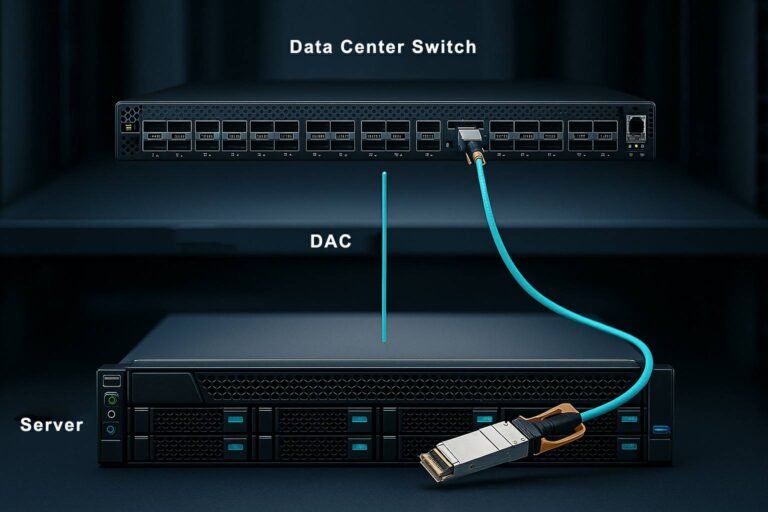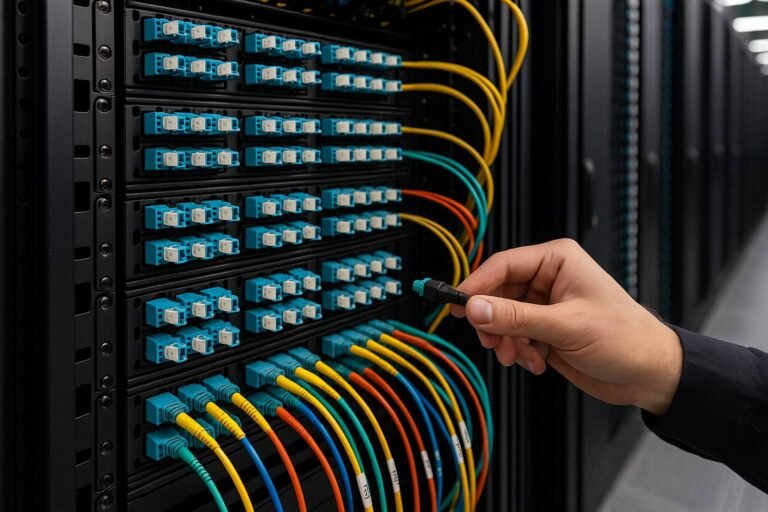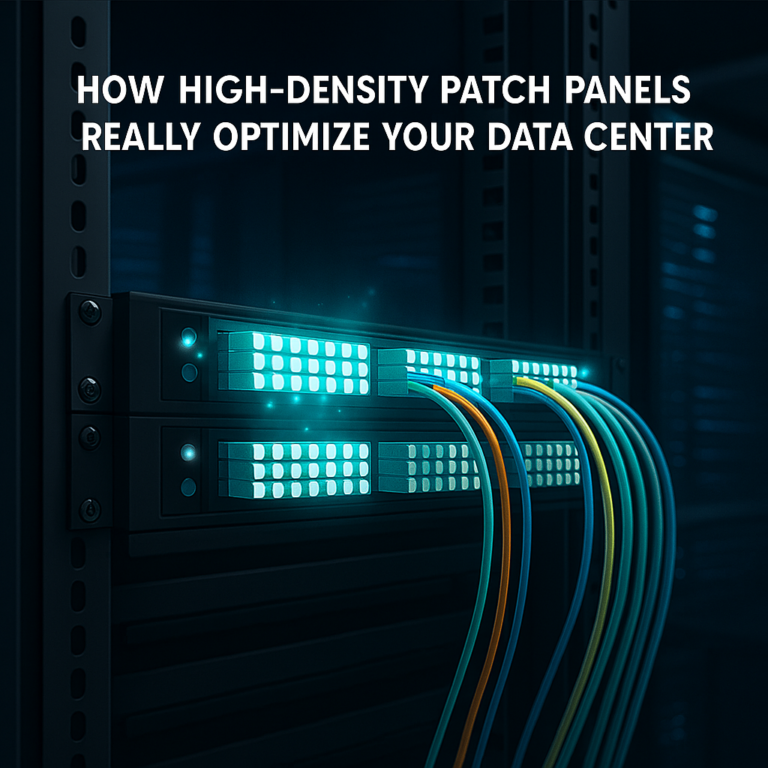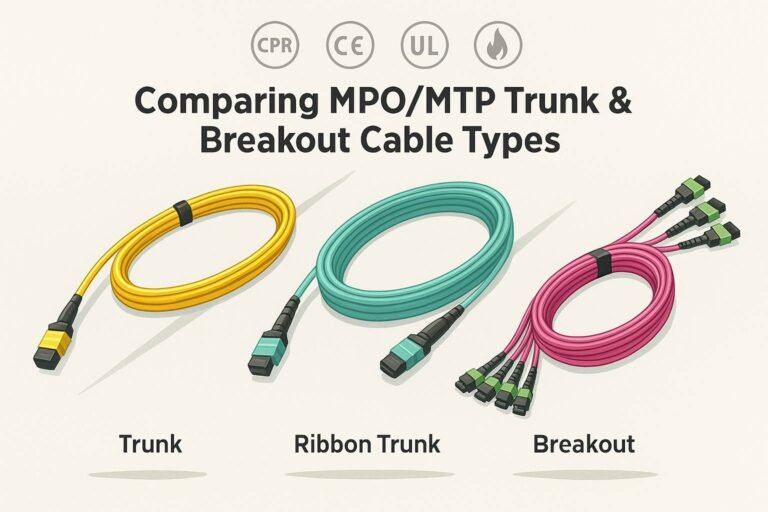How Does a PoE Switch Work in a Business Network?
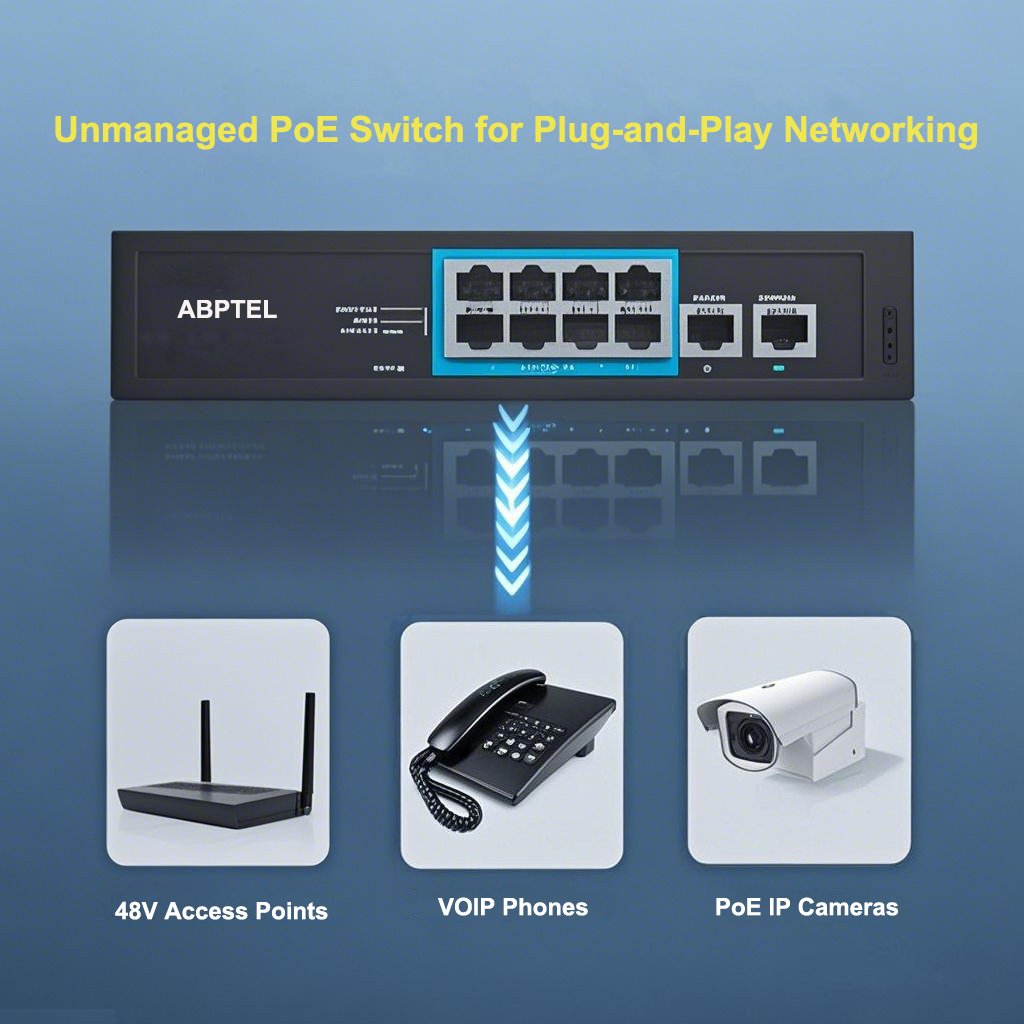
I remember when I managed my first office network. I felt overwhelmed by the mess of power adapters and cables. I needed a simpler way to connect IP phones, wireless access points, and cameras without installing extra power outlets. Then I learned about PoE switch for business network1. They helped me combine power and data in one cable. This solution cleared up the clutter and made my life simpler.
A PoE switch delivers both data and electrical power through one Ethernet cable. This means no separate AC outlets are needed for VoIP phones, IP cameras, or wireless access points. In a business network, this simplifies the setup, lowers installation costs, and offers flexible device placement. It also supports features like VLAN, QoS, and remote management for better network control.
Years ago, I had to wire an entire floor for new IP phones and cameras. The thought of adding separate power lines for every device was daunting. When I discovered that a PoE switch could push power over the same cable carrying data, I was excited. It felt like I had found the missing piece. I’ll explain how PoE switches fit into different business network architectures, how VLANs and QoS optimize traffic, and how remote management helps you keep everything running smoothly.
How Does a PoE Switch Fit into a Business Network?
At first, I saw a PoE switch as just a device that plugs into the rest of the network. But I realized that PoE switches are part of a broader design, which can be a star topology or ring topology or even a layered backbone. In business networks, each design has its strengths, and understanding them helps me decide where PoE switches can go.
PoE switches integrate seamlessly into different network designs. They can be placed at distribution points in a star topology, used to form resilient loops in ring networks, or serve as critical access layers in backbone architectures. Their main role is sending data while powering devices, all with a single cable.
PoE Switch in Various Network Designs
Star Topology
In many business environments, I see a star topology. There is a central core switch, and each device or sub-network (like a branch office floor) connects back to that core. A PoE switch in a star topology usually sits closer to the end devices—like cameras or phones. When I set up a star layout, each PoE switch often serves a specific department. This approach is simple because everything converges at a central point.
Key Points for Star Topology:
- Each PoE switch connects directly to the central core switch.
- Easier to manage but requires more cable runs.
- If the core switch fails, the entire network can be impacted.
Ring Topology
Sometimes, I work with ring topologies. Here, each switch connects to two other switches, forming a loop. Modern protocols (like Spanning Tree or others) prevent broadcast storms. A ring can offer redundancy. If a cable is cut, traffic can still flow the other way. PoE switches in a ring topology power devices in a continuous loop. If a link fails, the powered devices remain online if they have an alternate path.
Key Points for Ring Topology:
- Provides redundancy.
- Requires more complex configuration (Spanning Tree Protocol or equivalent).
- Good for industrial setups or large campuses needing failover paths.
Backbone or Core Layer
In big enterprises, there is often a layered design: core, distribution, and access layers. PoE switches typically appear in the access layer, where they power local endpoints—phones, cameras, access points. The distribution or backbone layer handles the high-throughput links connecting different parts of the network. When I design networks, I like to keep the PoE function near end devices. This makes sense because I do not need to run power from the core to each endpoint across long distances.
Table: Where PoE Switches Typically Reside
| Network Layer | Typical Role of PoE Switch | Example Devices Powered |
|---|---|---|
| Access Layer | Powers end devices like phones, WAPs, cameras | VoIP phones, IP cameras, WAPs |
| Distribution | Aggregates traffic from multiple PoE access layers | Switches bridging multiple floors |
| Core | Usually high-capacity routing/switching, not always PoE | High-speed routing gear |
I find that placing PoE switches in the access layer is the norm. It’s easier to manage, troubleshoot, and upgrade. However, I also see some organizations that use PoE even at the distribution layer if they need to power distribution-level devices (like certain specialized controllers or large screens).
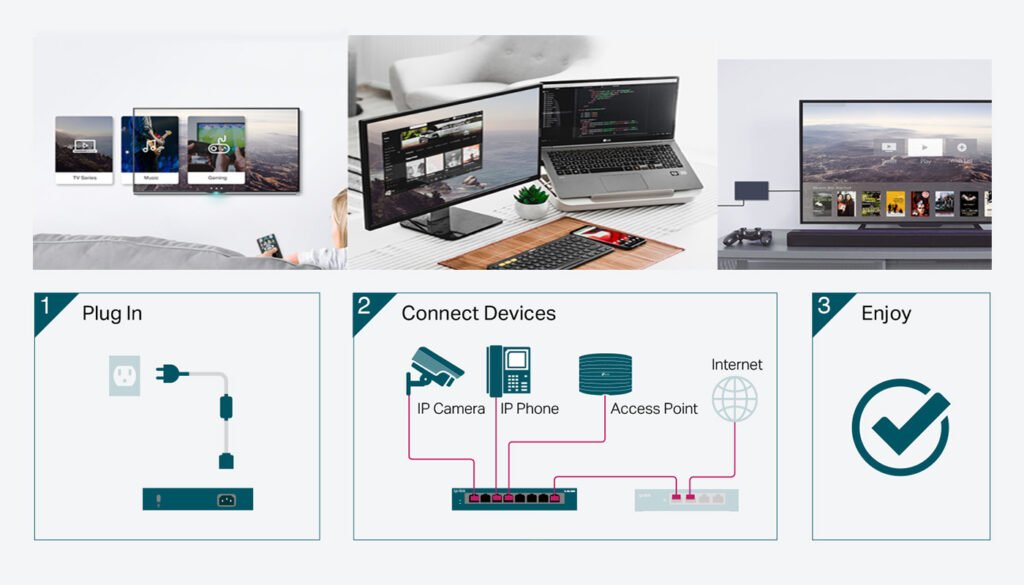
What Is the Network Architecture for PoE?
I used to think PoE was only about plugging devices in. But then I learned there are different ways to plan PoE networks, especially when you account for potential device growth, future expansions, and redundancy. Proper architecture ensures stable power delivery and data flow.
PoE network architecture can be star-based, ring-based, or layered with a backbone. Each approach depends on the size of the deployment, redundancy needs, and the number of powered devices. The architecture you choose impacts cost, ease of maintenance, and overall reliability.
PoE Network Architectures
Why Architecture Matters
I once worked in an office with 60 IP phones and 40 cameras. We initially placed all devices on one PoE switch. This overloaded the switch’s power budget. The architecture was not planned well. We split the network across two PoE switches eventually—one for half the cameras, the other for phones—because that balanced the power requirements.
Power Budget Considerations
Every PoE switch has a maximum power budget. For example, if a switch can supply 370W across 24 ports, you cannot exceed that total. If your devices collectively draw more than 370W, you’ll encounter failures or random shutdowns. Distributing devices across multiple PoE switches can help.
Below is a quick table that helps illustrate how power budgets come into play:
| Switch Model | Number of Ports | Total Power Budget | Max Power Per Port | Possible Deployment Scenario |
|---|---|---|---|---|
| PoE Switch A | 8 | 120W | 15.4W (802.3af) | Small office with basic phones and a few cameras |
| PoE Switch B | 16 | 240W | 30W (802.3at) | Medium business with PTZ cameras or advanced WAPs |
| PoE Switch C | 24 | 370W or 480W | 30W - 60W (802.3at/bt) | Larger site with mixed devices, multiple floors |
Endspan vs. Midspan
- Endspan (Mode A): The PoE switch itself is the power sourcing equipment (PSE). It provides power directly from its built-in ports.
- Midspan (Mode B): Used when I have a non-PoE switch. I add a PoE injector to insert power into the Ethernet cable.
I find that endspan is simpler if I’m buying new PoE-capable switches. Midspan can be a stopgap if I already have a good-quality non-PoE switch and only need to power a few devices. But for a large business network, I usually prefer an endspan approach with dedicated PoE switches. It’s neater and easier to manage.
Why Are VLAN, QoS, and Remote Management Valuable?
I used to assume PoE switches only provided power. Then I discovered the advanced features like VLAN and QoS that come in managed switches. These features let me segment the network and prioritize critical traffic. On top of that, remote management tools help me troubleshoot from anywhere. This is crucial for business networks that cannot afford downtime.
VLANs isolate network segments for better security and organization. QoS (Quality of Service) prioritizes important data streams, like voice calls. Remote management lets me configure or reboot PoE ports from a distance. These features transform a PoE switch into an intelligent networking device that goes far beyond powering endpoints.
Benefits of VLAN, QoS, and Remote Management
Understanding VLANs
A VLAN (Virtual Local Area Network) groups devices logically, even if they are physically scattered. For example, I can place all VoIP phones in VLAN 10, cameras in VLAN 20, and staff PCs in VLAN 30. This keeps broadcast traffic separate, improving network performance and security.
- Security: VLANs can restrict data exchange between groups.
- Organization: Easier to identify which device belongs to which VLAN.
- Scalability: If I add new devices for a department, I just assign them to the correct VLAN.
Example VLAN Table:
| VLAN ID | Department | Devices | Purpose |
|---|---|---|---|
| 10 | Voice | VoIP Phones | Dedicated for voice traffic |
| 20 | Surveillance | IP Cameras | Captures footage, security streams |
| 30 | Staff Network | PCs, Laptops | General office data traffic |
| 40 | Guests | Guest Wi-Fi | Internet access, limited resources |
The Power of QoS
Quality of Service ensures key traffic, like voice or video, gets priority. Without QoS, your voice calls might break up if someone does a large file download. I once had a client call to complain about choppy audio whenever employees downloaded big attachments. After enabling QoS on the PoE switch, the voice packets got priority, and the audio quality improved.
- Voice Prioritization: Keeps phone calls clear.
- Video Prioritization: Ensures real-time camera feeds or conferencing get enough bandwidth.
- Control Over Traffic: I can decide what traffic is mission-critical.
Remote Management Advantages
Managed PoE switches often come with a web interface, SNMP support, or a command-line interface. When something fails, I can log in remotely, check port usage, or even power-cycle a specific camera. I do not need to physically travel to each switch. This is invaluable, especially for large or multi-site deployments.
For detailed steps on setting up VLAN and QoS, you can refer to a comprehensive PoE Switch VLAN and QoS guide2. It outlines the typical configurations and best practices for business networks.
Table: Managed vs. Unmanaged PoE Switch Features
| Feature | Managed PoE Switch | Unmanaged PoE Switch |
|---|---|---|
| VLAN Configuration | Yes (802.1Q VLAN support) | No |
| QoS | Yes (802.1p or DSCP) | No |
| Remote Management | Yes (Web UI, SSH, SNMP) | No |
| Port Monitoring | Yes (Port statistics, RMON) | No |
| Cost | Higher | Lower |
| Deployment Scale | Medium to Large, mission-critical | Small, basic setups |
When I help a business plan for growth, I usually suggest managed PoE switches. They cost more initially, but the features pay off in the long run.
How Does a PoE Switch Actually Deliver Power?
I used to wonder, “How does data and power flow on the same cable?” It felt magical. But the technology is straightforward when you break it down. The PoE switch injects power onto certain twisted pairs in the Ethernet cable while transmitting data signals on other pairs (or sometimes on the same pairs, but different signal frequencies).
A PoE switch uses power sourcing equipment (PSE) logic to detect a connected powered device (PD). Once it recognizes a PD, it applies the right voltage. Standards like IEEE 802.3af/at/bt define how much power is delivered and how the handshake happens. This ensures devices only draw what they need.
The Electrical and Signaling Process
Detection Phase
When I connect a device to a PoE port, the switch initially sends a small current to check if the device is PoE-compatible. It looks for a characteristic signature. If the device is not PoE-capable, the switch does not provide power. This prevents damage to non-PoE devices.
Classification Phase
If the device signals it is PoE-ready, the switch may classify it into a power class. For example, a Class 1 device might need up to 4W, while a Class 4 device might need up to 25.5W. This classification helps the switch allocate power budget efficiently. In my experience, using a fully managed switch makes it easier to see these classifications through the management interface.
Power-Up Phase
After classification, the switch supplies the required voltage (often around 48V for PoE). Once the device boots, it draws only the current it needs. If the device tries to draw more, the switch can detect this and shut the port or notify the admin, depending on the settings.
Table: Basic PoE Power Classes
| Class | Usage | Maximum Power Range (at PD) |
|---|---|---|
| 0 | Default (Unclassified) | 0.44W to 12.95W |
| 1 | Very Low Power Device | 0.44W to 3.84W |
| 2 | Low Power Device | 3.84W to 6.49W |
| 3 | Mid Power Device | 6.49W to 12.95W |
| 4 | High Power Device (PoE+) | 12.95W to 25.5W |
| 5/6/7/8 (802.3bt) | Even Higher Power (PoE++) | Up to 51W, 71W, etc. |
Maintaining Power and Data
Once powered, the device receives data signals on the cable simultaneously. Ethernet is robust, using twisted pairs for noise cancellation. The PoE standards keep power injection within safe limits. I love how seamlessly power and data coexist.
Can PoE Switches Reduce Cable Clutter in Business Networks?
Before I used PoE, I placed separate AC adapters and cables for cameras and phones. The conference rooms looked messy. When clients visited, they noticed the tangle of wires. I decided to cut down on the clutter. PoE was my solution.
Yes, PoE switches can definitely reduce cable clutter. They remove the need for separate power cables by delivering both data and power through one line. This tidier installation not only looks better but also cuts costs and installation time, especially in large business deployments.
Practical Cabling Benefits
Single Cable, Dual Purpose
It might sound obvious, but once I used PoE, I had only one cable for each device. This made a difference. Technicians did not need to install power lines in challenging places.
Easier Troubleshooting
When I see a device offline, I can check a single cable path. Is it the Ethernet port, the cable, or the switch port? If it’s a separate power line, I might wonder if the outlet is working, if the adapter is functional, or if there’s a short circuit. PoE consolidates these concerns into one place.
Better Aesthetics and Professional Look
I set up a new office floor for a client. They wanted a polished environment, with minimal visible wires. PoE helped me run neat lines from a patch panel to various devices. No bulky adapters on the desks. They loved the clean appearance.
Quick Table: Cable Clutter Comparison
| Approach | Number of Cables per Device | Additional Power Adapters? | Installation Complexity |
|---|---|---|---|
| Traditional | 2 (Ethernet + Power) | Yes | Higher |
| PoE | 1 (Ethernet with PoE) | No | Lower |
Conclusion
When I look back, I see that PoE switches fundamentally changed how I design business networks. They offer so much more than just a power source. By combining data and electricity in one cable, they reduce costs, simplify installation, and enhance flexibility. They fit well in star, ring, or layered backbone architectures, and they excel at powering IP phones, cameras, and wireless access points. Beyond that, advanced features like VLAN segmentation, QoS for prioritizing voice and video, and remote management help me maintain and optimize the network from anywhere. I see PoE as a wise investment, particularly for businesses planning to expand or modernize.
A PoE switch works by integrating power sourcing equipment (PSE) capabilities into a standard network switch. It detects and classifies powered devices (PDs) like VoIP phones, IP cameras, or WAPs, then supplies the appropriate voltage through an Ethernet cable. This synergy of data and power allows a single-cable setup, removing the need for separate power lines. In business networks, PoE switches can be placed in star topologies, ring topologies, or layered architectures. Depending on deployment size and device requirements, one must consider the total power budget, VLAN segmentation, QoS policies, and remote management capabilities. VLANs isolate traffic for security and better organization, while QoS ensures critical data (like voice) is prioritized. With remote management, IT staff can monitor or troubleshoot ports from afar. By streamlining cables and offering advanced features, PoE switches make networks more efficient, scalable, and easy to maintain. All of this combined leads to cost savings, simpler installations, and better user experiences.

